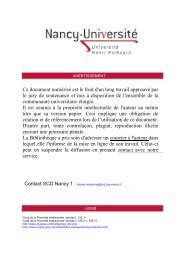Ce document numérisé est le fruit d'un long travail approuvé par le ...
Ce document numérisé est le fruit d'un long travail approuvé par le ...
Ce document numérisé est le fruit d'un long travail approuvé par le ...
Create successful ePaper yourself
Turn your PDF publications into a flip-book with our unique Google optimized e-Paper software.
152<br />
hydrolyses triglycerides present in very lowdensity<br />
lipoproteins and stimulates LDL<br />
uptake [56]. PPARa increases the<br />
transcription of apolipoproteins AI, AIl [57,<br />
58] and inhibits the transcription of<br />
apolipoprotein CIlI [59] resulting,<br />
respectively, in modulation of high density<br />
lipoprotein-mediated chol<strong>est</strong>erol transport and<br />
in increase of lipoprotein lipase activity.<br />
Within the cens, intrace11ular transport is<br />
facilitated by stimulation of ppARadependent<br />
target genes such as fatty acid<br />
transport protein, fatty acid translocase and<br />
hepatic cytosolic fatty acid-binding protein<br />
[60, 61]. Uptake of <strong>long</strong>-chain fatty acids<br />
involves activation into acyl coA thio<strong>est</strong>ers by<br />
acyl-coA synthetase [60] and subsequently<br />
degradation by the peroxysomal ~-oxidation<br />
pathway which enzymes are regulated by<br />
PPARa [62-65]. Long-chain fatty acids import<br />
into mitochondria is regulated by ppARadependent<br />
carnitine palmitoyl transferase l<br />
[66-68]. Furthermore, link between<br />
mitochondria metabolism and ppARadependent<br />
regulation has been provided from<br />
the identification of functional PPRE on<br />
promoters of the ~-oxidative medium chain<br />
acyl-coA deshydrogenase gene [69] and 3<br />
hydroxy-3-methylglutary1-coA synthase gene<br />
[70], the rate limiting enzyme of ketogenesis.<br />
Data from ppARa knoutout mice also<br />
demonstrated that ppARa positively regulates<br />
constitutive mitochondrial ~-oxidation [71]. In<br />
these mice, feeding with a high fat diet <strong>le</strong>ads<br />
to lipid accumulation in the liver ref<strong>le</strong>cting the<br />
reduction of mitochondrial <strong>long</strong> chain fatty<br />
acid import. It must however be note that<br />
ppARa knoutout mice have metabolic<br />
changes including high chol<strong>est</strong>erol <strong>le</strong>vels and<br />
low ~-oxidation [72] and changes in<br />
lipoprotein metabolism [73]. Final1y, liver<br />
ppARa transcriptional <strong>le</strong>vel is under the<br />
control of circadian <strong>le</strong>vels of glucocorticoids<br />
<strong>le</strong>vels which <strong>par</strong>ticipate to energy<br />
mobilization [74]. Fasting or glucocorticoids<br />
stress also induce ppARa expression in<br />
hepatocytes [74, 75].' In addition to its<br />
implication in liver, ppARa also alters<br />
Hervé Schohn et al.<br />
thermogenesis in adipose tissue by modulating<br />
the expression of uncoupling protein 1 and 2<br />
[76, 77]. Uncoupling protein-1 in rat brown<br />
adipocytes is also regulated by PPARy [76].<br />
Adipocyte differentiation<br />
Adipocyte differentiation is a comp<strong>le</strong>x process<br />
<strong>le</strong>ading to changes in gene expression [78-80].<br />
This process involves CCAATT/enhancer<br />
binding proteins [81-83] and PPARs. PPARy<br />
is implicated in terminal adipocyte<br />
differentiation. Murine ppARy2 was initia11y<br />
cloned as a component of an adipocytespecific<br />
transcription factor ARF6 and found<br />
to be the heterodimer mPPARy2lRXRa [84].<br />
It regulates the expression Of adipocyte fatty<br />
acid-binding protein aP2 [84], and<br />
phosphoenolpyruvate carboxykinase [85],<br />
which are markers of terminal adipocyte<br />
differentiation. Likewise, ppARy regulates the<br />
expression of lipoprotein lipase, fatty acid<br />
transport protein and fatty acid translocase in<br />
an adipocytic-specific manner [56, 61].<br />
Fina11y, there is a dramatic increase in the<br />
expression of ppARy-dependent and<br />
CCAAT/enhancer binding protein-dependent<br />
target genes during cell differentiation and<br />
maturation [86, 87]. Activation of ppARy<br />
with thiazo1idinedione also increases the<br />
number of small preadipocytes in rat white<br />
adipose tissue [88]. Subsequently, these ce11s<br />
undergo growth arr<strong>est</strong>' and subterminal<br />
differentiation into adipocytes. The initial step<br />
of preadipocyte proliferation may depend on<br />
activation of ppAR~/o [89] In any NIH-3T3<br />
fibroblasts lineage, a model of preadipocyte<br />
differentiation into adipocytes, treatment with<br />
cAMP e<strong>le</strong>vating agents and activation of<br />
ppAM promote mitotic clonai expansion<br />
[89]. In addition, in 3T3C2 fibroblasts,<br />
ppARo activated by fatty acids induce ppARy<br />
target -gene [90].<br />
The pivotaI ro<strong>le</strong> of ppARy was demonstrated<br />
by different ways : Retroviral expression of<br />
ppARy2 induces adipocyte differentiation in<br />
cultured mouse fibroblasts [91].
















